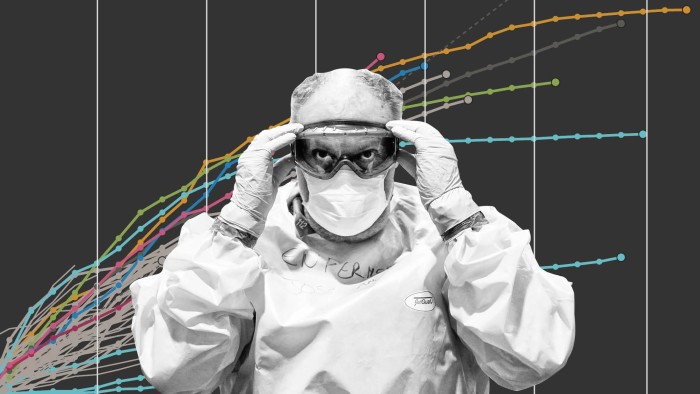Sarah Gilbert, the researcher leading the race to a Covid-19 vaccine

Roula Khalaf, Editor of the FT, selects her favourite stories in this weekly newsletter.
When Sarah Gilbert heard about a mysterious new respiratory infection spreading in China in early January, she immediately wondered whether this was the long-dreaded Disease X — a previously unknown pathogen that would cause a catastrophic pandemic.
The vaccinology professor at Oxford university’s Jenner Institute had been preparing for just such a momentous event. Her lab had developed technology to create vaccines against virulent viruses. As soon as Chinese scientists published genetic details of the new coronavirus — providing a target for vaccine development — she moved ahead at full speed.
This week, Oxford published encouraging results from the first phase of testing of its ChAdOx1 vaccine, showing it generated antibodies and immune cells to recognise and kill the Sars-Cov-2 virus responsible for Covid-19.
“It is truly astonishing that, within 100 days of learning the genetic sequence of the virus, Sarah and her team were able to begin a clinical trial of the vaccine,” says John Bell, Oxford’s senior medical professor. “She is a terrific scientist. She knew exactly what was needed and was absolutely effective at getting it done.”
With 22 other potential vaccines also in clinical trials and more than 100 at earlier stages of research, the 300-strong Oxford team has competition. “The Oxford vaccine is the leader but that doesn’t mean it will win in the end,” admits Sir John, adding that the world will need several Covid-19 vaccines.
So far, in terms of demand, Oxford is well ahead. Since the university made pharmaceutical company AstraZeneca its commercial and manufacturing partner, the vaccine has won advance orders for more than 2bn doses from around the world — subject to safety and efficacy tests with tens of thousands of participants in coming months.
Prof Gilbert, 58, has become the public face of the project — although, like many scientists, she is a reluctant celebrity. She speaks confidently about the project at occasional press teleconferences but interviews are rationed and largely avoid personal matters. “My family want to keep their private lives to themselves,” she says firmly.
Latest coronavirus news

Follow FT's live coverage and analysis of the global pandemic and the rapidly evolving economic crisis here.
She is, however, willing to disclose a bit about herself. “I was born in Kettering [Northamptonshire] and grew up there, only leaving for university,” she says. “My mother was a primary school teacher and my father was office manager for Loake Bros shoes.”
After a biology degree at the University of East Anglia, she completed a PhD in biochemistry at Hull university, followed by jobs in the biotech industry at the Brewing Industry Research Foundation, Leicester Biocentre and Delta Biotechnology. In 1994, Prof Gilbert joined Oxford’s Nuffield Department of Medicine where she has worked ever since.
She gave birth prematurely to triplets in 1998. In an article for the university about work-life balance she wrote: “Nursery fees would have cost more than my entire income as a postdoctoral scientist, so my partner has had to sacrifice his own career in order to look after our children.”
The triplets are now following in their mother’s footsteps, with all three studying biochemistry at university. They were also early volunteers for the clinical trial of Oxford’s Covid-19 vaccine.
When Prof Gilbert began her Oxford career, she focused on malaria, before moving on to flu vaccines. After becoming professor of vaccinology in 2010, she started work on the approach that led to ChAdOx1. This uses a genetically engineered chimpanzee adenovirus — which causes mild cold-like symptoms in apes but does not normally infect people — to carry elements of a harmful virus into human cells, where they stimulate the recipient’s immune system.
At the time that Covid-19 appeared, Prof Gilbert was applying the technology to some of the nastiest viruses known to medicine, including Nipah, Lassa and Rift Valley fever. But, significantly, her lab had already produced a vaccine against Middle East Respiratory Syndrome — a lethal disease caused by another coronavirus. This provided a model for the Covid-19 vaccine.
Prof Gilbert is reluctant to predict whether and when ChAdOx1 will move beyond clinical trials to vaccinate large numbers against Covid-19. There are three elements of uncertainty, she says.
First, it is not clear how long the trials will take to produce results. It will depend on how much virus is circulating in the places where the testing is taking place, which include Brazil, South Africa and the US. Then, AstraZeneca and its manufacturing partners must organise production on a huge scale. Finally, the regulators must decide whether the vaccine works well enough to be approved: the US Food and Drug Administration has set a 50 per cent efficacy threshold for Covid-19 vaccines.
If all goes well, the Oxford team says ChAdOx1 might be available by the end of the year to vaccinate the highest priority recipients, with supplies expanding rapidly during 2021.
As others take charge of the manufacturing and regulation, Prof Gilbert continues to lead the research in Oxford, making sure the trials run smoothly and the team’s work is communicated promptly in scientific papers.
At the same time, she is thinking of how to make vaccine research more efficient than was possible in January. “We are still thinking about Disease X,” Prof Gilbert says. “If we’d had everything in place this time, we could have been at least a month faster, which would have made a big difference.”
Comments